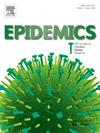Modelling the interplay between responsive individual vaccination decisions and the spread of SARS-CoV-2
IF 2.4
3区 医学
Q2 INFECTIOUS DISEASES
引用次数: 0
Abstract
Background
COVID-19 vaccine hesitancy proved to be a major barrier to higher uptake, but it is unclear whether interventions targeting hesitancy could result in substantial prevention benefits. Epidemic models that represent vaccine decision-making psychology can provide insight into the potential impact of vaccine promotion interventions in the context of the COVID-19 pandemic and future epidemics of vaccine-preventable diseases.
Methods
We coupled a network- and agent-based model of SARS-CoV-2 transmission with a social-psychological vaccination decision-making model in which vaccine side effects and breakthrough infections could “nudge” individuals towards vaccine resistance while spikes in COVID-19 hospitalizations could nudge them towards vaccine willingness. This model was parameterized and calibrated to represent the COVID-19 epidemic in Georgia, USA from January 2021 to August 2022. We modelled counterfactual scenarios in which increases to resistant-to-willing nudges were combined with decreases to willing-to-resistant nudges. We compared cumulative vaccine doses administered, SARS-CoV-2 incidence, and COVID-related deaths across scenarios.
Results
Increasing the probability of hospitalization-prompted resistant-to-willing nudges increased vaccine uptake by as much as 5.4 % and decreased SARS-CoV-2 incidence by as much as 4.0 %. In contrast, decreasing the probability of breakthrough infection-related willing-to-resistant nudges had a negligible impact on further vaccination and disease outcomes.
Conclusions
Vaccine promotion interventions that address community-level factors influencing decision-making may have a greater ability to avert SARS-CoV-2 infections than those targeted to individual vaccination and infection history. Additionally, reactive vaccine promotion interventions may have only limited prevention benefits in the short term, suggesting that attention should be paid to formulating interventions that accurately anticipate the case curve.
对反应性个体疫苗接种决策与SARS-CoV-2传播之间的相互作用进行建模
背景:covid -19疫苗犹豫被证明是提高吸收率的主要障碍,但目前尚不清楚针对犹豫的干预措施是否能带来实质性的预防益处。代表疫苗决策心理的流行病模型可以深入了解在COVID-19大流行和未来疫苗可预防疾病流行背景下疫苗促进干预措施的潜在影响。方法将基于网络和代理的SARS-CoV-2传播模型与社会心理疫苗接种决策模型相结合,其中疫苗副作用和突破性感染可能“推动”个体对疫苗产生耐药性,而COVID-19住院治疗的高峰可能推动他们对疫苗的意愿。对该模型进行了参数化和校准,以代表2021年1月至2022年8月在美国佐治亚州的COVID-19流行。我们模拟了反事实的情景,在这种情况下,从抵抗到愿意的推动的增加与从愿意到抵抗的推动的减少相结合。我们比较了不同情况下的累积疫苗剂量、SARS-CoV-2发病率和covid相关死亡。结果增加住院诱导的耐药-自愿轻推的概率,可使疫苗接种率提高5.4% %,使SARS-CoV-2发病率降低4.0% %。相比之下,降低与感染相关的突破意愿的可能性,对进一步接种疫苗和疾病结果的影响可以忽略不计。结论针对社区层面决策影响因素的疫苗推广干预措施可能比针对个人疫苗接种和感染史的干预措施更能避免SARS-CoV-2感染。此外,反应性疫苗推广干预措施在短期内可能只有有限的预防效益,这表明应注意制定能够准确预测病例曲线的干预措施。
本文章由计算机程序翻译,如有差异,请以英文原文为准。
求助全文
约1分钟内获得全文
求助全文
来源期刊

Epidemics
INFECTIOUS DISEASES-
CiteScore
6.00
自引率
7.90%
发文量
92
审稿时长
140 days
期刊介绍:
Epidemics publishes papers on infectious disease dynamics in the broadest sense. Its scope covers both within-host dynamics of infectious agents and dynamics at the population level, particularly the interaction between the two. Areas of emphasis include: spread, transmission, persistence, implications and population dynamics of infectious diseases; population and public health as well as policy aspects of control and prevention; dynamics at the individual level; interaction with the environment, ecology and evolution of infectious diseases, as well as population genetics of infectious agents.
 求助内容:
求助内容: 应助结果提醒方式:
应助结果提醒方式:


